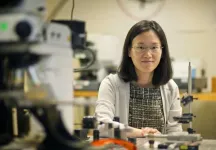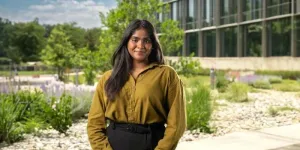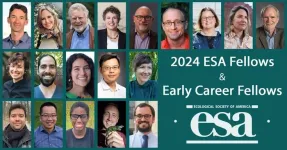(Press-News.org) Four U-M projects funded by the Department of Energy's Nuclear Energy University Partnerships program aim to make nuclear energy safer and more equitable.
The projects are designed to improve the monitoring of nuclear reactors during operation; explore the safety of an advanced modular reactor design; develop a framework for ethical, consent-based siting of nuclear facilities; and upgrade a facility for modeling radiation damage to reactor components.
Real-time radiation effects on optics
How well could optical sensors monitor future advanced nuclear reactors? Funded with $1 million, Igor Jovanovic, a professor of nuclear engineering and radiological sciences, will lead a project that seeks to understand how materials used in optical sensors behave in real time when exposed to radiation. The findings may also improve sensor designs and placement, ensuring safer and more efficient operation of future advanced reactors.
The team will study how radiation affects the transparency and density of materials like glass and sapphire, commonly used in optical sensors. Using gamma rays and neutrons to simulate reactor conditions, they'll measure how the materials change during irradiation and immediately afterward, focusing on shorter wavelengths important for certain types of sensors.
Gas-cooled fast reactor safety
Can a promising advanced reactor cope with accidents safely? Xiaodong Sun, a professor of nuclear engineering and radiological sciences, will lead an investigation into the behavior of a helium-gas-cooled fast modular reactor (FMR) should its normal reactor cooling system malfunction.
Funded with $1.1 million, Sun's team will construct a test facility to experimentally study how coolant flows during these accident scenarios. By integrating these experimental results with detailed computer simulations, the researchers aim to develop more accurate computer models to better predict reactor behavior during hypothetical accidents, helping improve the reactor's design while ensuring safety and reliability.
The reactor that Sun's team will study—the FMR being developed by General Atomics Electromagnetic Systems, a California-based company—can use fuel more completely and effectively than conventional water-cooled reactors, promising to produce less nuclear waste. The modular design offers more flexible energy generation, likely with lower upfront costs than conventional nuclear power plants.
Community consent in nuclear facility siting
Many American tribes have a history of harmful experiences with nuclear projects, as uranium mining and weapons testing have resulted in environmental contamination and related health issues. Aiming to end this pattern, a $1.1 million project will incorporate the perspectives and experiences of these communities into guidelines and tools for consent-based siting of nuclear facilities.
The effort is led by Aditi Verma, an assistant professor of nuclear engineering and radiological sciences at U-M, with critical contributions from Robert Geroux, a political theorist and faculty member in the American Indian Studies Program at Eastern Washington University.
"Dr. Geroux has been collaborating with the University of Michigan team over the last two years to create a living archive of protocols for engagement with tribal communities," Verma said. "His expertise will be essential in doing this work in a way that centers accountability to our community participants."
Upgraded facility for studying damage to reactor components
The Michigan Ion Beam Lab can mimic many aspects of the radiation damage that nuclear reactor components experience over time. It matches overall damage by shooting ions of the type found in the material being tested. These atomic 'bullets' create the damage experienced in a nuclear reactor. The lab can also use hydrogen and helium beams to help create bubbles in the material, similar to bubbles formed when neutrons from the fission reaction interact with reactor component materials—an effect known as transmutation.
Funded with $410,000, Kevin Field, an associate professor of nuclear engineering and radiological sciences, will lead a project to upgrade the way the lab generates and measures helium damage at high temperatures, enabling the facility to mimic more reactor types.
More information on these projects, and other projects that the U-M is participating in, can be found on the Nuclear Engineering and Radiological Sciences website.
END
$3.6 million to advance nuclear energy awarded to U-M
The Department of Energy will support research into nuclear reactor monitoring, safety and aging as well as community consent in nuclear facility siting
2024-04-30
ELSE PRESS RELEASES FROM THIS DATE:
Two UT Arlington faculty honored for outstanding research
2024-04-30
The University of Texas at Arlington is honoring two faculty for their outstanding contributions to research.
Yuze (Alice) Sun, associate professor of electrical engineering, and Venu Varanasi, associate professor in the Bone Muscle Research Center, are the 2024 recipients of the University Award for Outstanding Research Achievement or Creative Accomplishment. This award recognizes faculty members for achieving significant research or creative accomplishments during the past three years.
“Alice and Venu are truly bright stars on the faculty at UT Arlington,” ...
UT Arlington student links worm behavior to brain disease
2024-04-30
As an undergraduate student in The University of Texas at Arlington’s Honors College, Hannah Selvarathinam knew she wanted to conduct research. Near the end of her first year at UTA, the Keller native reached out to the lab of biology Assistant Professor Piya Ghose.
“Hannah has been a very impressive scholar from Day 1,” Ghose said. “She had the foresight to reach out for research opportunities very early on.”
Ghose brought Selvarathinam in to work on one of the lab’s core projects ...
Uncovering the secret of long-lived stem cells
2024-04-30
Nothing lives forever, but compared to other cells in the body, hematopoietic stem cells (HSCs) are remarkably long-lived. HSCs are blood-forming cells – they give rise to rapidly dividing progenitor cells, which in turn generate hundreds of billions of cells to fulfill the daily demand of oxygen-delivering red blood cells, disease-fighting white blood cells and clot-forming platelets.
HSCs typically remain dormant within the bone marrow, yet they possess the ability to activate and replenish blood cells continuously, maintaining a relatively youthful profile throughout the life of an organism. What is the secret of ...
The question for online educational platforms: offer courses following a schedule or release them on demand?
2024-04-30
Researchers from Carnegie Mellon University and University of Pennsylvania published a new Journal of Marketing study that examines online educational platforms and the question of whether they should release content through a scheduled format that resembles a traditional university course or use an on-demand release strategy.
The study, forthcoming in Journal of Marketing, is titled “More Likely to Pay but Less Engaged: The Effects of Switching Online Courses from Scheduled to On-Demand Release on User Behavior” and ...
Study: racial bias is no 'false alarm' in policing
2024-04-30
Black drivers are more frequently searched during traffic stops without finding contraband than white drivers, according to a University of Michigan study.
Institute for Social Research scientists Maggie Meyer and Richard Gonzalez analyzed data from 98 million traffic stops, and showed that innocent Black drivers were likely to be searched about 3.4 to 4.5 percent of the time while innocent white drivers were likely to be searched about 1.9 to 2.7 percent of the time. Their results are published in the Journal of Quantitative Criminology.
"We show that there's ...
Ecological Society of America announces 2024 Fellows
2024-04-30
The Ecological Society of America is pleased to announce its 2024 Fellows. The Society’s fellowship program recognizes the many ways in which its members contribute to ecological research, communication, education, management and policy. This year, the ESA Governing Board has confirmed nine new Fellows and ten new Early Career Fellows.
Fellows are members who have made outstanding contributions to a wide range of fields served by ESA, including, but not restricted to, those that advance or apply ecological knowledge in academics, ...
Mass General Brigham researchers identify potential drivers of chronic allergic inflammation
2024-04-30
Currently, most therapies for allergic diseases require lifelong treatment. Allergic reactions, characterized by ongoing (type 2) inflammation in response to chronic antigen exposure, underlie many chronic diseases in humans, including asthma, atopic dermatitis, ulcerative colitis and more. T helper 2 (Th2) cells play an important role in the body's immune response, particularly in allergic reactions. Despite their central role, the sustained activity of Th2 cells during allergic reactions, even in the face of constant antigen exposure, has long puzzled researchers.
A research team that included authors from Mass General Brigham, including ...
Scientists solve chemical mystery at the interface of biology and technology
2024-04-30
Link to release:
https://www.washington.edu/news/2024/04/30/oects/
Researchers who want to bridge the divide between biology and technology spend a lot of time thinking about translating between the two different “languages” of those realms.
“Our digital technology operates through a series of electronic on-off switches that control the flow of current and voltage,” said Rajiv Giridharagopal, a research scientist at the University of Washington. “But our bodies operate on chemistry. In our brains, neurons ...
Shaping the Future of Neuroendocrine Tumor Management
2024-04-30
MIAMI, FLORIDA (April 30, 2024) – Newly updated guidelines on neuroendocrine tumors developed by an expert at Sylvester Comprehensive Cancer Center at the University of Miami Miller School of Medicine and collaborators provide clinicians with the latest recommendations for staging and management of these rare but increasingly diagnosed tumors.
The guidelines, developed for the American Joint Committee on Cancer (AJCC) and summarized today in CA: A Cancer Journal for Clinicians, highlight recent changes for treating these tumors and offer a snapshot of this rapidly evolving ...
Scientists show ancient village adapted to drought, rising seas
2024-04-30
Around 6,200 BCE, the climate changed. Global temperatures dropped, sea levels rose and the southern Levant, including modern-day Israel, the Palestinian territories, Jordan, Lebanon, southern Syria and the Sinai desert, entered a period of drought.
Previously, archaeologists believed that this abrupt shift in global climate, called the 8.2ka event, may have led to the widespread abandonment of coastal settlements in the southern Levant. In a recent study published with the journal Antiquity, researchers at UC San Diego, the University of Haifa and Bar-Ilan University share new evidence suggesting at least one village formerly thought abandoned not only remained occupied, but ...
LAST 30 PRESS RELEASES:
American College of Cardiology comments on new dietary guidelines for Americans
American Society of Gene & Cell Therapy and Orphan Therapeutics Accelerator partner to advance and commercialize promising rare disease treatments
One in 14 patients having day case surgery have new or worse chronic pain 3 months after their operation
New study highlights link between eviction rates and gun violence
Heatwaves heat up soil but not toxin levels in rice, study finds
Digital modeling reveals where construction carbon emissions really come from
Turning farm waste into water filters
New study shows how the spleen helps the immune system accept a transplant
New Mayo Clinic study advances personalized prostate cancer education with an EHR-integrated AI agent
Researchers identify novel therapeutic target to improve recovery after nerve injury
Microbes in breast milk help populate infant gut microbiomes
Reprogramming immunity to rewrite the story of Type 1 diabetes
New tool narrows the search for ideal material structures
Artificial saliva containing sugarcane protein helps protect the teeth of patients with head and neck cancer
Understanding the role of linear ubiquitination in T-tubule biogenesis
Researchers identify urban atmosphere as primary reservoir of microplastics
World’s oldest arrow poison – 60,000-year-old traces reveal early advanced hunting techniques
Bristol scientists discover early sponges were soft
New study uncovers how rice viruses manipulate plant defenses to protect insect vectors
NSF–DOE Vera C. Rubin Observatory spots record-breaking asteroid in pre-survey observations
Ribosomal engineering creates “super-probiotic” bacteria
This self-powered eye tracker harnesses energy from blinking and is as comfortable as everyday glasses
Adverse prenatal exposures linked to higher rates of mental health issues, brain changes in adolescents
Restoring mitochondria shows promise for treating chronic nerve pain
Nature study identifies a molecular switch that controls transitions between single-celled and multicellular forms
USU chemists' CRISPR discovery could lead to single diagnostic test for COVID, flu, RSV
Early hominins from Morocco reveal an African lineage near the root of Homo sapiens
Small chimps, big risks: What chimps show us about our own behavior
We finally know how the most common types of planets are created
Thirty-year risk of cardiovascular disease among healthy women according to clinical thresholds of lipoprotein(a)
[Press-News.org] $3.6 million to advance nuclear energy awarded to U-MThe Department of Energy will support research into nuclear reactor monitoring, safety and aging as well as community consent in nuclear facility siting




